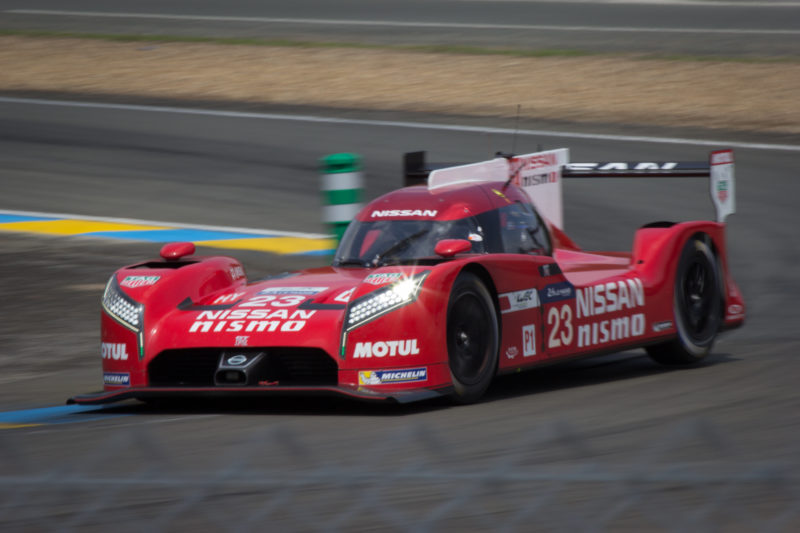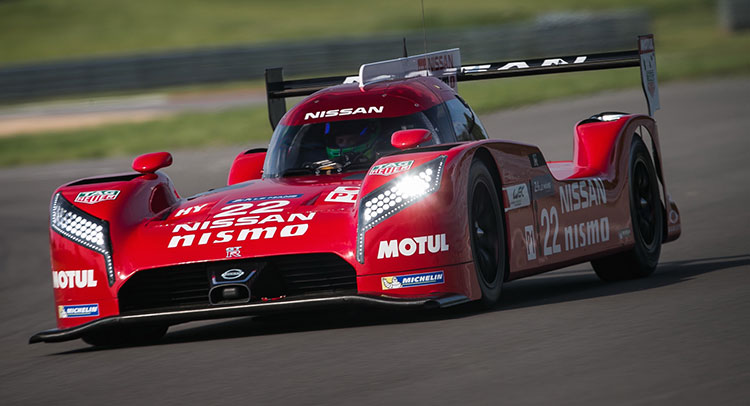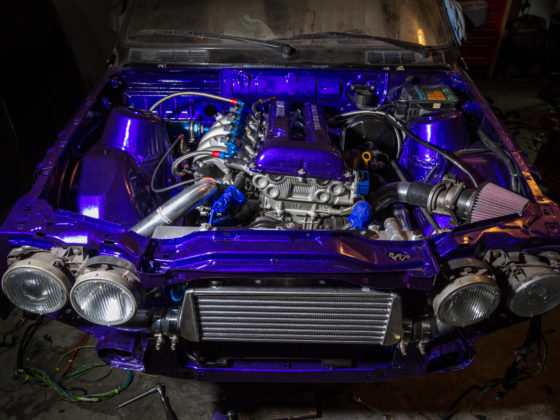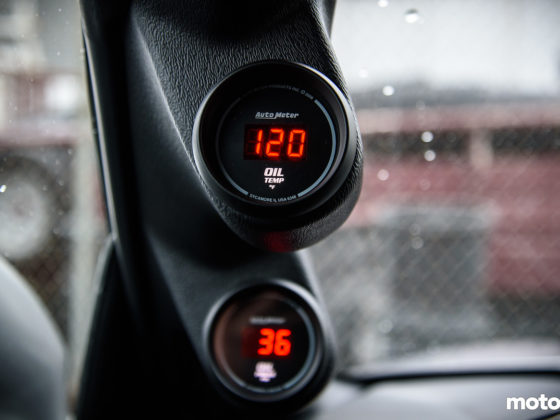
It’s been a long-standing opinion of mine that a front engine layout can potentially work better for Prototype racing.
A front engine car can easily be packaged into a body shape like an upsidedown wing with a huge rear diffuser with no engine or transaxle to get in the way of the aerodynamics. The cars aerodynamic center of pressure can easily be in the back of the center of gravity to give the car inherit stability as well.
So when rumors surfaced about Nissan developing a Ben Bowlby (the father of the Deltawing prototype) designed front engine hybrid AWD prototype for LeMans I was ecstatic. I was also cautious in my enthusiasm because this would be a car pushing the edge of technology and I always feel that this isn’t a good way to win races. I also felt that Nissan’s Ghosn era management would be too stingy with funding and push too hard for timing for this project to be developed properly. Turns out I was right on all counts.
The car was radical, A 3-liter twin turbo V-6 was developed by Cosworth and Supplemented by a Torotrak KERS system powered the racer. The IC engine drove the front wheels and the KERS system drove both the front and rear wheels through a bespoke Xtrac transmission/center diff arrangement. The rear wheels were powered with offset driveshafts and hub mounted epicyclic transmissions in a radical bespoke arrangement designed so driveshafts would not compromise the cars underbody aero with its huge diffuser and flow through bodywork.
The car was plagued with development problems from the start. The powertrain didn’t fit in the carbon tub properly and the car failed FIA crash testing. There was little time allocated for testing and early tests went poorly. Nissan management pushed for the car to make the race. The car was doomed to do awfully in LeMans like it was being set up to fail.
Nissan entered a 3 car team in the 2015 running of LeMans. Due to development problems, the KERS system was not working and the cars ran only in FWD mode with overstressed brakes that were designed for the energy absorption of KERS. With the technical issues and rushed development, the cars were 20 a lap seconds off the pace. During the race, two cars broke early and one car sort of finished in dead last, the car spent so much time in the pits repairing damage from striking debris.
With these humiliating results, Nissan pulled the plug on what was supposed to be a 2-year minimum program. Poor Ben Bowlby, another one of his radical ideas dead due to inadequate funding and development. I myself would like to see a Prototype developed using this concept but as an electric hybrid with electric pancake motors in the rear hubs. This would simplify things and package better as well as probably perform better.
Anyway, the Nissan Prototype was a lot more successful as a cool Super Bowl commercial. The car was showcased in what I think is the best car commercial ever. It tugged on my own heartstrings because I have always and still do regret the time racing and business travel has taken away from my own daughter and myself having grown up with a largely emotionally absent Dad.
Here is the commercial if you don’t remember it.
Here is a cool mini-documentary on the making of the commercial.
Anyway, I hope someone still tries to build the super aero, front engine AWD hybrid prototype, I think it would kick ass! I would love to work as an engineer for the team that develops and fields it.




28 comments
It’s a double side sword basically. I’ve worked with a couple of manufacturers on racing cars. Problems always arise when dealing with management. Then again: Problems also arise with engineers as well. Managers look to heavily at the financial numbers and time crunch. Engineers look to heavily on inovating and making the best stuff possible. Those 2 worlds just collide on a regular basis. So rest assured: It isn’t any different at other companies. The higher up in the food chain racing gets, the more difficult it becomes, because engineers and managers grow more apart, focussing more on more on what they are good at, without thinking about the rest. It’s also why I quit doing it on that level.
It is also why I quit as well.
Figures! But then again: If I waited for less then a year, Toyota would have pulled the plug anyhow and I would have been layed off along with the rest of the staff. And finally giving one the finger actually felt like a relief!
I think the best factory programs were NPTI and the TRD program of the late 90’s where they were independent corporations under the company umbrella but with their own management teams and budgeting. Those programs ran well. NPTI was pretty good until they decided to go Indy racing and started splitting the budget to finance Indy R&D. Then the GTP car quit winning, Tom Migdinelli got sacked as Nissan CEO and the plug was pulled before the Indy effort could be launched. From that point, Nissan began its long backward slide from a maker of cool great performing cars with a cool motorsports program to become the maker of shitty cars that you buy when no other make will give you financing!
On that side of the pond they where. On this side of the pond it would be Toyota Motorsport GMBH. Also under the direct umbrella of Toyota. Responsible for the WRC Celica and Corolla. The Toyota GT-One at Le Mans, and of course Toyota F1 (where I entered the fray). The problem with big budgets (in my time about €400.000.000,–) coming from manufacturers directly is that they want results. But the people promissing those results are usually not the real engineers, but the managers. Thats what finally pulled the plug in 2009, about 7 months after I left.
Then again: I for one could honestly say that I could have made Toyota F1 world champion in 2006. The budget was there, the new engine regulations ment that everybody needed to start fresh. I made one of the best breakthroughs back then in engine design and on chassis development. But lo and behold: My name wasn’t on the designer part of the engine and the chassis. And instead it was somebody else, which I won’t name, but has the same first name as you. Bastard took a lot of credit for my ideas. But did not implement all of them. He got sacked the same year. So even between engineers there is a lot of rivalry going in inside the same team. And we where hampered by RPM restrictions lobbied by mainly Ferrari. Engine was capable of 24.000 RPM compaired to rest of the fields 18.000 RPM. So with the restriction in place it was down 130 BHP. Al the above still gets me angry….
So after 2006 the decline in my pleasure in motorsports began. Luckaly I’ve always had a love for motorsports from a fairly early age (about 6 years old) , so I still do it, albeit at a much slower pace. The same goes for development. I decided back then to pursue another career altogether, but still be involved on a basis of enjoyment. So every once in a while I still take on a project, and I still write for a local magazine for classic cars from time to time. Thats where my real passion lies nowadays: Anything ranging from the 1930’s up until the late 70’s. Thats still more passion then work really. But at least I can say that I enjoy it, without all the people nagging around me.
I think how well front engine prototypes works sort of depends on the state of the rest of the rules; in 2015 there were a lot more restrictions on rear downforce generating elements than front so moving so much to the front made a lot of sense. With the open IMSA/GrC rules of the 80s/90s, it’s arguable… the one attempt, the Mustang, had other issues, and in the flat bottom LMP1 era, the Panoz seemed respectable.
It’s definitely cool to see noticeably different things out on track though.
I think the Mustang was doomed due to the motor.
Yeah, and Ford’s management attitudes towards the motor and some other things. No way to say in retrospect though.
The Polymotor was way ahead of its time, even today! Then the conventional motor that replaced it was not designed to be a stressed member. Boom!
I read the Polimotor was based on the Pinto engine, but was it supposed to go in the Mustang GTP? It was raced in a Lola T616 and according to the team the plastic bits didn’t break.
The aero advantage in the second paragraph was also the reasoning behind the Mustang GTP, but drivers said handling was severely affected when the fuel was low.
Eh? Polimotor was in one of the Camel Lights entries, NA. The Mustang GTP car was a Zakspeed project offshoot of either their old German Group 5 engine from the Capri, or an offshoot of their F1 engines, I’m not sure which. Zakspeed were probably overstretched at that point and it was never reliable.
None of the ones you mentioned: They where actually group B engines from the Ford program out of the RS200. Based on the BDA.
The Polymotor was developed for the Mustang GTP car and although it ran ok on the dyno, it blew up when used as a stressed member in the chassis. I think it was based off the Cosworth BDA but I am not 100% sure on that. I think it might have gone on with more development in Camel Lights but that’s not the way I remembered it. It was a long time ago though.
It was BDT based (as mentioned RS200 but also RS1700t). Zakspeed was definitely overstretched at that point and had too small of a US operation.
Yeah, it’s not that simple.
Zakspeed was doing things with the turboed modified BDAs in the touring car series I mentioned in the 70s on their own, well predating the RS200… and if you look at pictures, there’s casting differences in the heads between the Zakspeed provided motors the Mustang and Probe GTP cars were using and the normal or even RS200 BD engines. In addition to the fact that the intake and exhaust are flip/flopped on the Zakspeed provided engines and the belt drive is completely different.
Oops, replied to wrong thing. Oh well whatever.
Uhm not really? Lets have a recap: Lotus developed the Ford BDA engine in 1962, form the kent block from Ford (kents where the OHV design started in 1959). Mike Costin and Keith Duckworth, worked at Lotus and helped develop the engine. The started there on company called Cosworth (Cos-Worth) who took over production from Lotus in 1962.
In essence there where quite a few BDA engines that aren’t officially BDA engines, But BDB, BDC, BDD, etc. Different displacement al the way up to 2 liter, and all the way down to 0.8 liter.
Originally called the BDT (Belt Drive Turbo). It was created in 1981 for the Ford Escort RS1700T (which never raced). It did feature in the RS200 in 1984. The GTP mustang wasn’t introduced untill 1984. The Turbo Capri was introduced in 1980, but with a cast iron block. They differ slightly in cc’s as well. The Ford is a couple cc’s bigger then the Zakspeed is.
As for the headcasting: You are right about that. The ford units are cast iron blocks with an aluminum head. Thats why they could handle the pressure. The Zak Speed engines in the GTP, are as far as I understand are aluminum blocks? I could be wrong though, as the change happened somewhere in the early 80’s at Zakspeed (and Hart I might ad), and I haven’t worked on a Mustang GTP.
The heads where in essence the same design as the cosworth engine, but featuring different webbing. Valvetrain is exactly the same though. I’ve helped prepare the Ford Zakspeed Turbo Capri from 1980 in its later years at Mücke Motorsport.
As I suspect it’s in essence the casting thats the wrong choice in retrospect. It may be lighter, but lighter doesn’t always mean its faster…. Where the aluminum engines worked marvels running NA (zakspeed even based their F1 engine design around the BDA) , the couldn’t quite handle the torque of the turbo. But In essence they are the same design as the cosworth/lotus/ford design, only with a different name and slightly different details….
I kinda remember that there was an aluminum 2-liter version of the BDA sold here that was run in midgets?
Do you want to write for us?
Thats always a possibility, but it depends on a lot of things? Can I send you a email? You can probably see my email as well, so can you send me one what you had in mind?
There’s a lot of little details there that are wrong, like how you mixed up the Lotus Twin Cam with the BDA and Duckworth had started Cosworth before that… also the Zakspeed Capri turbo was on track in ’78 and predating the “official” BDT. My whole point though is that from all accounts I’ve seen the units Zakspeed was giving Ford for the Mustang GTP was a privateer developed engine done without Ford resources – from a program separate from Group B (which Zakspeed had nothing to do with as far as I could tell) and leveraging off of none of Ford’s engineering expertise or money funnel that was going to Group B. Just a huge weird political mess when they could have had basically the same thing done in house and probably done better. It might have been a more successful car with a Group B derived BDT or BDT-E.
Though yes they all have BDAs and Kents as ancestors.
Did you ever see the twin cam next to the BDA? They aren’t really that different. Main difference is the Belt. And sure, 8v vs 16v and they didn’t have the intake cast in the head.
Duckworth and Costin started Cosworth before that, but because of work intention had been signed by Costin he didn’t leave, and only worked there in the after hours. Duckworth did leave lotus in 1958 however. Costin did the same in 1962.
As for 1978. Your right, but lets not forget that those where division 2 spec, not division 1 like the 1980 capri The 1980 capri did actually win the championship, but that got overturned after protestst from the competition (aero advantage). But even after all points where deducted, and aero became more restricted they still won races.
If thats true that a mess! Why in the world would the use a private engine builder? Or was that because the engine was in essence European and Ford USA wouldn’t endorse that?
Twink and BDA were definitely the same idea… but a lot of different concepts. Belt vs chain like you mention, 2 vs 4 valve, integral manifolds, and twink had integral cam carriers. Had some once for a Europa before we traded that for RX-7 parts.
And yeah, what I’ve read the Mustang GTP program *was* a huge mess! Apparently Zakspeed did all the engine work in Germany, so the team would get a crates of longblocks just in time for the race weekend without time for testing and shakedown… throw one in the car, it would do a few laps then grenade (or apparently sometimes on first startup) they’d put in another one for qualifying and another one for the race… and then they’d ship them all back to Germany. Contrast that to the BDT/BDT-E or even the IMSA GTO SOHC turbo engines… it’s extremely weird to me.
What I’m seeing with a little bit of digging is down to Michael Kranefuss, who became motorsports director and head of SVO but had previously worked with and driven for Zakspeed in Europe in their touring car stuff. Mention I’m seeing is Zakowski was adamant about not consulting with Cosworth on any of it – possibly related to what they were trying to do in F1 at the time too. Roush wanted to put a V8 in it and was overruled and left the program.
Hey Kevski, really interesting reading your experience with F1 engine development. I remember one of my teachers, Claude Rouelle from Optimum G, talking about his experience with Toyota F1 and how they had 900 engineers each pulling on their corner of the covers and how it was basically a lack of a clear direction/vision that doomed them.
I was visiting Northampton the week after the brexit vote for a promotional tour of motorsport manufacturers. I remember thinking “I would love to work here” after visiting Prodrive, Cosworth and FormulaE garages at Donington Park. From an outsider it looks like the center of the racing world.
Would you say it’s worth it to move there to work for a few years to gain some experience and fill up a resume? Your comments above made it look like you were glad to get out, is the work environment that hard or was it just F1?
The scene where they fire up the GTR-LM Nismo after its stop sent chills down my spine when I first saw it. That was the coolest piece of automotive footage I’d ever seen up to that point.
The main problem with the Super Bowl commercial is that whoever signed off on the choice of background music apparently didn’t listen to the song all the way through, and had no idea what happened on the next two verses.
hrm. i wonder if he did end up borrowing his dad’s car keys though…